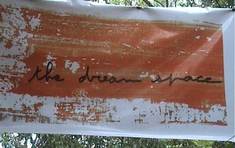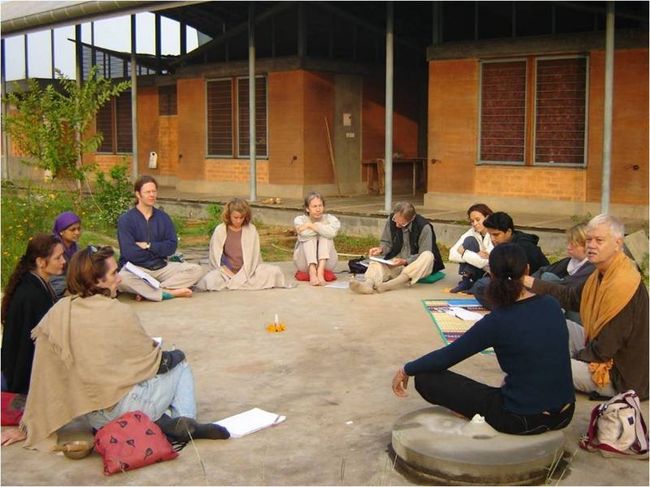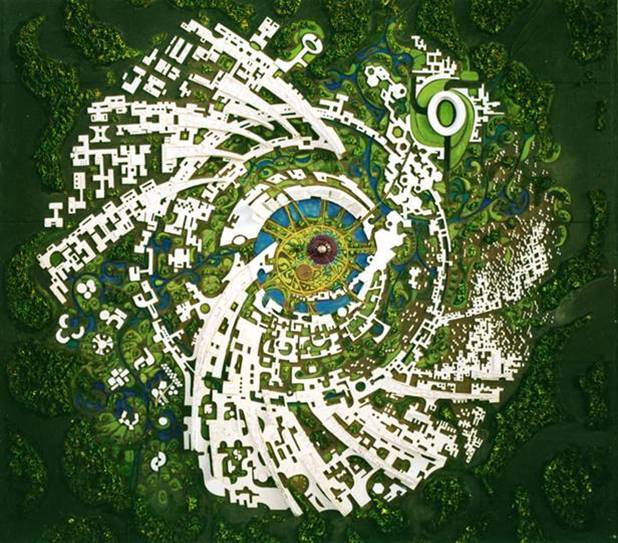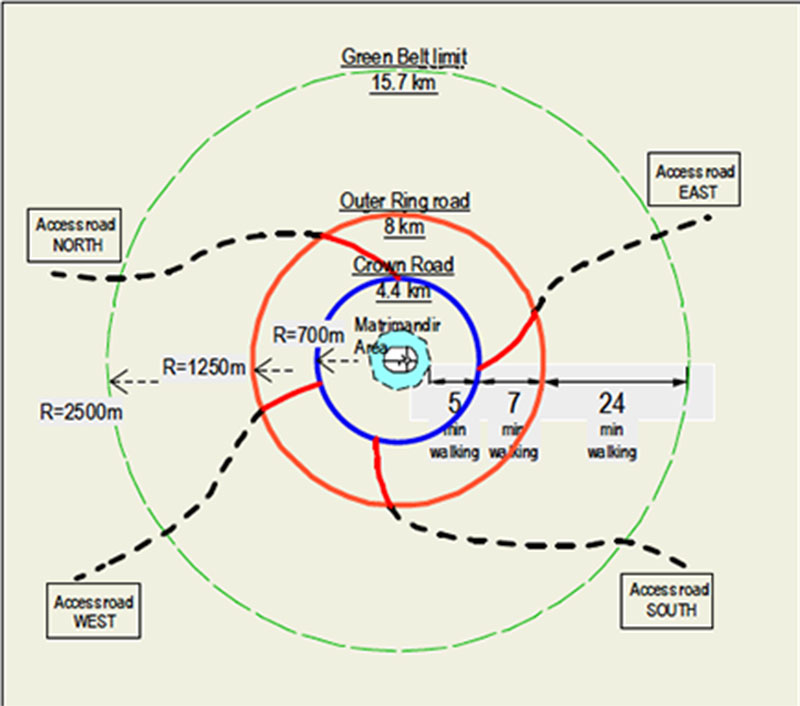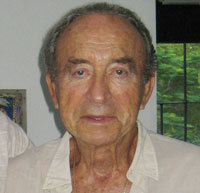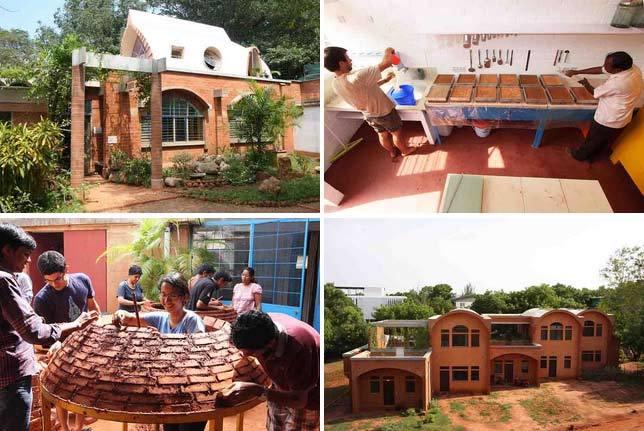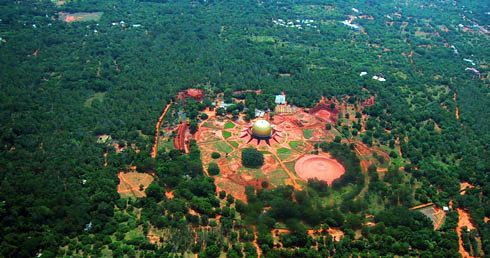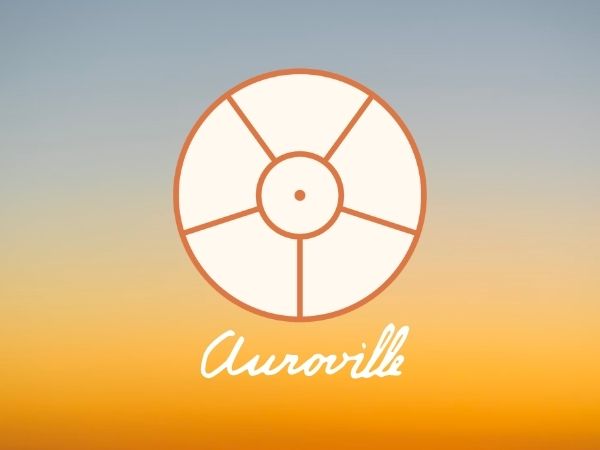Last updated:
Raising the bar on mobility and urban planning
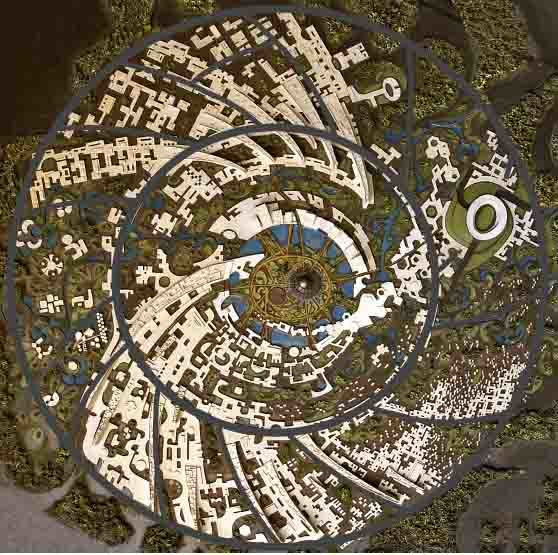
Architect David Nightingale has been developing a plan for Auroville’s Cultural Zone, which has led him to more broadly consider Auroville’s urban planning and mobility issues. He recently presented his proposal A Strategic Approach to Mobility on the Crown in Auroville, which was well received. This is an edited transcript of an interview with him.
Auroville Today: So, let’s start with the early architectural models for Auroville. You believe that the Galaxy Model didn’t specifically designate the Crown to be a road?
David: That’s how I interpret it. When you look at the Galaxy Model, there are no roads in the image – in profound contrast to all of Roger’s earlier proposals. If you zoom in, you can see that the Crown unfolds around the circle, creating a very dynamic mixture of different elements. The blue-green and white elements can be interpreted in different ways. The white can obviously be seen as buildings, but could also be covered spaces, or hard landscaping extending on the ground. The only visible circle seems to be more like a canal linking the spaces between the built sections. But the first thing people ask me when I describe it like that is, ‘What?! Do you really think there will be no roads?’ But the Galaxy Model is a concept model, it’s not meant to answer all the questions straight away. Just because we see what looks like a canal running around the Crown, it doesn’t mean Mother was imagining a Venice of south India with gondolas moving around – we shouldn’t take it literally. But as a concept model, it emphasises some elements over others. It’s a product of 1968 and the culmination of the work Mother and Roger did together, but I believe it’s meant to be reinterpreted as we go along. It’s not cast in stone,and I believe it’s our task to tease out solutions from it. Evolution is a fundamental part of the Integral Yoga, so it fits for me that we have an evolving urban plan that’s adapting as we evolve.
How well have we succeeded in doing this?
We have not given sufficient attention over the years as to how to interpret the Galaxy Model, and have developed a Master Plan focused primarily on efficiency. In my view, we’ve boiled down complex aspects into lowest common denominator solutions. What we’re doing today in Auroville is the opposite of what most of the cities in the world that we consider beautiful have done. Our design decisions are responding to engineering decisions, and not the other way around. The engineering solutions should instead provide the solutions to our designs. We’ve focused on the essence of what we need – roads, cables, sewage pipes, water – and turned it into an engineering challenge since this is something that we can easily get our heads around. And as a result, in my view what we’re seeing today, ten years after the first paved roads were started, is the opposite of what the Galaxy Model represents and the opposite of what the Mother asked for. We have over-simplified the challenge she put in front of us, in order to have the feeling that we’re achieving something, and by doing so we’re failing day by day to embrace the higher challenge.
For example, if I take the original Galaxy Model, and superimpose a grey circle to show what will happen to it conceptually if we build the Crown as a road – as Auroville has started to do – it shows how the whole connectivity and energy flow of buildings and spaces, and the movement of people, is completely cut. The heart and soul of the township becomes amputated from the rest. If the road is completed as it exists today, the Crown will become the absolute antithesis of the Galaxy Model that Mother approved.
So how did Mother envisage mobility?
The Mother apparently said that we should be travelling at a maximum of 25 kilometres per hour within the city, which means in essence that we should be moving consciously and slowly, and I would also add quietly. So, Auroville was not supposed to be a high-speed city, and it’s not about getting from A to B as fast as we can.
What role has the Master Plan played in the development of roads?
Roger presented the Galaxy Model just before the inauguration, and I like to think Mother took one look at it and with a twinkle in her eye thought ‘That will keep them busy.’ If she’d wanted us to build something easy, she could have simply chosen the first Grid Model. It would have been finished years ago. In the end it’s a blessing that it wasn’t finished in five or ten years, since if it had been, we would have probably ended up with a South Indian Brasilia, Canberra or Chandigarh frozen in time – a snapshot of a futuristic vision from the late 60s. The Galaxy Model is a nightmare from a planning point of view, and that’s exactly the point. It has amazing qualities and amazing depth to it, which is what we’re being asked to explore. We should be collectively going as high and as wide as we can, to work out how that would look today, including all the ecological and technological advances that have been made in the meantime. The Master Plan was supposed to be reassessed every five years. Twenty years later, it has not been reassessed once. I don’t know why that is, but we all need to become more proactive and more involved to address this lacuna.
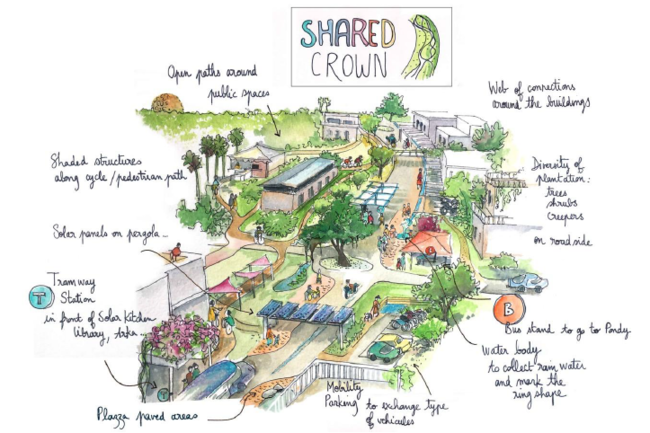
Because wide roads have been built, that means that cars come?
Yes, the traffic planner Karl-Heinz Posch predicted this back in 2008 and advised against it – it’s naïve to think that we can build all these roads, and then everyone will be just cycling on them or taking electric buses. Those hopeful visions ignore present circumstances and human nature. Unfortunately, humanity only usually wakes up once we’ve made some mistakes. The Dreamcatchers presented an alternative Crownways in 2008, before the road was paved, to show how we could create beautiful public spaces which would not encourage fast, heavy traffic. But it seems there was a commitment to continuing with the status quo of the Master Plan with the Crown and Radial roads etc., which is what we have today. Aurovilians generally accept the need for quiet, non-polluting transport, but people are reluctant to sacrifice the creature comforts of their day-to-day life. They may not want to pay more for it, to take longer to get somewhere, to wait for a bus, etc. But for alternative mobility to have a chance, the majority of residents all have to want it .
What is your suggested solution?
I’m suggesting we develop an alternative mobility in phases, and create a series of urban spaces along the Crown. And where the peramboke [common village] land crosses the Crown, you’d have a crossover point, a place where someone coming from Certitude can park their noisy vehicle, and get on an electric cycle or take a shuttle and spend a couple of hours going around the Crown, doing their shopping and going to the library, and then park the electric cycle and get back on their vehicle to go back to Certitude. As we create each section, we’ll learn from our mistakes and add new technology as it comes on-line. This was also proposed in 2008 but it was probably too ambitious for that time, because the range of options around electrical vehicles – now provided by Kinisi and ITS and City Transport – weren’t there then. But the proposal sowed the seeds, and those 12 years have enabled our electric transport infrastructure to evolve, and now it’s just about ripe to handle a proposal like this.
We could also develop the Crown in different ways in different parts. Take Marie’s sketches [see illustrations on page 4] that show what the Crown could look like, and imagine you’re travelling around the Crown on the electric shuttle. The first image shows how the Crown might look where the van passes through Darkali. There’s very sparse housing around there within one of the parks, and there’s a more alternative ‘eco’ feeling with a bamboo bus stand, etc. It has a very different quality to the next picture, which shows the Crown at the Solar Kitchen roundabout.That area is currently very open and sterile, so I suggested to Marie that she draw the road tighter and curvier (to ‘de-road’ it in fact), to put a market near the road and to put a banyan in the middle of the roundabout.
What are the issues with getting such designs implemented? Is it to do with L’Avenir?
L’Avenir d’Auroville is supposed to be the interface between a planning office and the community. Rather than thinking that they should be doing all the work, they should ideally be reaching out to the community for guidance. Our dreams are constantly ahead of our capacity to manage them. We need to find money for a technical office to do the planning. I would like to stress we are all L’Avenir, we are all Auroville. As long as we choose to give away the power and have these decisions made in our name, we’ll keep getting roads. That’s not a judgement on anyone. If you give the job of creating a system of electrical cables for Auroville to an electrical engineer, and if they don’t have any other plan to respond to, they’ll simply come up with the most efficient solution possible. They aren’t doing anything wrong, but no one has set the bar higher. So by default, we’re getting engineering solutions because the engineers are doing their job in a design vacuum.
Does that ‘low bar’ also explain why there are more cars in Auroville?
We have an ageing population, and many of them don’t feel safe anymore on a moped. Some people get cars because it’s more comfortable to have air-conditioned transport in the summer months, and yet others use them because they are ‘differently-abled’. However, the more cars there are, the more danger on the roads, so people want more cars. As long as we have motorcycles driving at maximum speed and ever-increasing volume on the Crown, the urban artery of Auroville, no one can live or work comfortably there. The units operating in Kalpana, for example, apparently hire rooms in other parts of Auroville for important meetings, because their own offices are too noisy due to the loud vehicles on the road outside – and if they don’t do that yet, they probably soon will.
So this is exactly the right moment to introduce an alternative. Rather than continuing the American model where you drive to the post office, and then to the library, and then to the Solar Kitchen for lunch, we need to create beautiful urban spaces where people can walk or cycle, and to invert the hierarchy so that pedestrians have priority, then cyclists, then collective transport, then private electric vehicles, and then, last of all, private non-emission-free vehicles. By the way, when I talk about polluting, I’m not pretending that electric vehicles are not polluting. But I don’t want an alternative mobility solution to get bogged down in those discussions, which can continue in the background if necessary. Let’s just accept that everything is polluting in some form or another, but that if we want to create beautiful urban spaces, we have to do it with solutions that are quiet and non-polluting at the place where the engine is running.
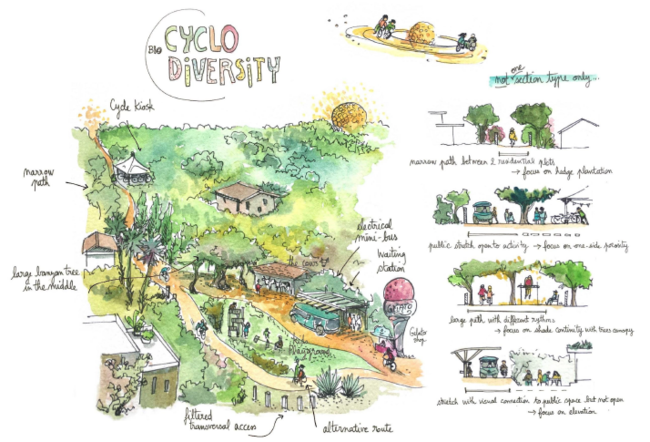
Doesn’t the problem of transport also have to do with urban planning and access to services? For instance, the many Aurovilians who are not members of PTDC [which has a long waiting list] currently have to travel some distance to HERS or PTPS in Kuilapalyam just to do simple grocery shopping because there is nowhere in the centre for them to buy the basics. Shouldn’t the basic services be offered to all residents within accessible distances?
Absolutely. Firstly, we need a new PTDC, and many agree about that. And we also need public transport – there’s the new proposal for La nAVette. People are trying to approach this from different perspectives. And there’s no silver bullet. I think we need all these approaches. As each new approach comes online, we will learn what works. With the situation you’ve described, it’s easy for people to justify having to have a motorbike to do that. It’s the easy, lowest common denominator solution, but ultimately I don’t believe that we all came to Auroville for that.
An elderly Aurovilian should also not be expected to have to go to the old Pour Tous to do some shopping if they don’t wish to. There should be a shopping service, and baskets could be delivered. We need a new PTDC somewhere on the Crown. Or create a second Solar Kitchen somewhere else, and the new PTDC could be combined with that.
What’s your proposed solution for the Crown?
It’s primarily a design challenge. You can see in the two illustrations how, with some simple design interventions, you can de-road the road and make public spaces more intimate and welcoming. Just imagine any townscape from 100 years ago with a series of plazas and squares – Rome being a perfect example. I believe Mother saw a similar approach in Roger’s Galaxy Model: a series of spaces like pearls on a necklace, and you go through the buildings to get to the next one. Those traditional qualities were lost in many cities around the world after the Second World War, because the advertising gods did a great job of selling us the car, connected to the idea of the suburb. We effectively sold the quality of urban space to the supposed carrot of freedom of independent movement. However, if we plan it right, almost no one will need a car in Auroville.
I recently came up with a proposal to help manifest such an alternative Crown by designating different parts of Auroville for different value systems. For example, an area where there is zero cash exchange, or an area for people living lightly in temporary housing, or areas that encourage people to be entrepreneurial. There could even be an area for teenagers nearer the tar-road who want fast noisy motorbikes. So you actually encourage people to live in the most suitable area, and the planners need to just accept that that’s part of the natural growth of both people and towns. The problem right now is that the most sensitive people are living amongst those who are less sensitive to their requirements, and who want to drive their noisy motorcycles wherever and whenever they want. But if we accept human nature as evolving, we can plan for different areas which people would naturally gravitate towards according to their values.
And do you think people will use a public transport system here, providing it is a good one?
If we create a beautiful inspiring Crown, that has no noisy traffic with lots of people living there and lots of activity, and there’s a café on the ground floor, and services like a library and a Pour Tous just two minutes’ walk away, more people will want to live on it. And if we have an electric shuttle bus going in each direction around it, and if people living on the Crown could jump on it and reach a class at Savitri Bhavan in five minutes, why wouldn’t they do that? And if they needed go to Pondicherry, and there’s a bus going every hour, why wouldn’t they take the bus? There is an argument that we don’t have the population yet for this to succeed, but if we don’t plan alternatives now, it will simply be too late.
What about Aurovilians who manage production units, who need to move around Pondicherry in order to buy supplies?
Auroville should be buying in bulk. It shouldn’t be sending a painter to Pondy to buy a few cans of paint for one person’s apartment. There should be a central buying agency on the tar road where painters can call the day before, and they just go there the next day on their electric vandi to pick it up. It just needs some imagination.
Auroville has been progressive in so many things, but has lagged behind global standards for transport. Is there hope?
There’s always hope. I think things generally happen in the right moment. My experience with Dreamcatchers was that we sowed a lot of seeds, and they germinate as and when we are ready. As time goes on, I’d like to see less fear of things going wrong, and less of a need for control. If you look at the Galaxy Model and what’s on the ground today, almost nothing that’s been built actually relates to it, and yet it’s coming from decisions that are supposedly trying to save it. This latest mobility proposal is just that, a proposal, it is not necessarily the answer but really just a starting point for someone to come up with an even better plan.
In conversation with Lesley
Whole article courtesy of Auroville Today magazine
